Managing warehouses across borders is a significant pain point for e-commerce businesses due to complexities in compliance, logistics, and costs. Different countries have varying regulations, taxes, and customs procedures, making it difficult to maintain efficient and cost-effective operations.
Furthermore, the need to manage inventory across multiple locations, each with its own unique requirements, adds to the operational burden.
Table of Contents:
Each country has its own set of rules regarding import/export, customs duties, and taxes, requiring significant expertise and resources to navigate. Plus, coordinating shipping, handling returns, and managing inventory across different countries with varying infrastructure and logistics networks is a major undertaking. This results in increased costs involving higher shipping costs, duties, and taxes, impacting profit margins and potentially making products less competitive.
Also, monitoring stock levels across different warehouses and ensuring timely fulfillment can be difficult, potentially leading to stockouts or excess inventory.
But it doesn’t end here!
Customers get delayed shipments, which makes them unhappy with the service quality. And the business loses one customer at a time or rather several customers due to this. That’s not all, huge volumes of transactions and data across borders also increase the risk of cybersecurity threats and fraud.
Country-Specific Ecommerce Rollouts Pain Points
Expanding your eCommerce operations into new countries is often seen as a growth milestone. But for many CXOs, the path to ecommerce localization is riddled with logistical bottlenecks, operational silos, and uncontrolled costs, especially in the areas of fulfillment and warehousing.
Recommended Reading:
Here’s where most country-specific store strategies go wrong:
Disconnected fulfillment & warehousing ecosystems
Most organizations spin up separate fulfillment workflows for each country—often managed through isolated warehouse management systems (WMS), third-party logistics (3PL) providers, or legacy integrations. The result includes no centralized visibility into inventory or order movement, no synchronization between what’s shown on the storefront and what’s available in the warehouse, and not a single source of truth for reporting or forecasting. This leads CXOs to lose control over cost-to-serve metrics, SLAs are broken, and customer satisfaction plummets.
Separate systems mean order delays & inventory errors
When each regional warehouse operates in a silo, the commerce backend can’t automatically coordinate stock levels, availability, or delivery timelines. This results in duplicate inventory entries across regions, error prone manual updates, and orders placed for out-of-stock items.
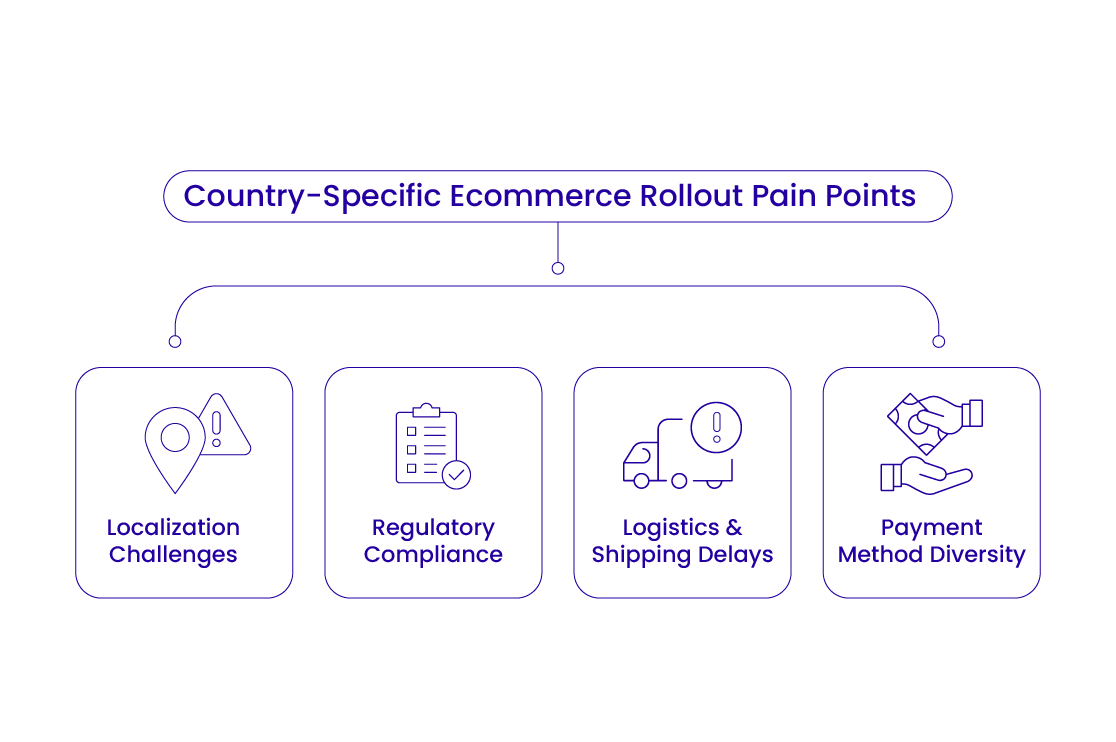
No intelligent order routing
Without automated, location-based order orchestration, fulfillment becomes inefficient and expensive. Orders aren’t routed to the closest, most cost-effective, or best-stocked warehouse, leading to slower shipping times, unnecessarily high last-mile delivery costs, and missed delivery promises due to improper regional coordination.
Shipping cost spikes from lack of regional logic
One of the biggest hidden costs in country-specific ecommerce website rollouts is logistics inefficiency. Without integrated warehousing and routing logic, shipping becomes a catch-all operation that prioritizes fulfillment over profitability. Orders should be fulfilled from wherever they can be and not where they should be. Also, cross-border tariffs, duties, and compliance costs add up due to misaligned fulfillment paths.
The Smarter Multi-Store Ecommerce Solution: One Backend, Many Frontends
In today’s hyper-competitive global eCommerce landscape, businesses can’t afford the inefficiencies of duplicated infrastructure. Leading organizations are moving away from siloed, country-specific setups and embracing a centralized, scalable architecture that enables global ecommerce store expansion without ballooning costs or complexity.
This smarter international ecommerce strategy combines a centralized backend with regionally tailored frontends, enabling organizations to deliver hyperlocal experiences while maintaining a single source of truth for inventory, customer data, order flow, and fulfillment.
Global expansion often hits a wall when logistics and fulfillment operations become fragmented. A smarter approach begins with unified fulfillment of global ecommerce store architecture, where global commerce is run from a central hub, but fulfillment is decentralized through multiple regional warehouses or 3PLs. Instead of managing disparate fulfillment systems for global ecommerce, CXOs can rely on a centralized command center that tracks and orchestrates order routing, fulfillment statuses, returns, and inventory allocation in real time.
With modern & modular multi-region eCommerce platforms like Magento, Shopify Plus, or Salesforce Commerce Cloud, it’s entirely possible to build country-specific experiences where language, currency, product catalog, and tax rules are all unified.
But what does it mean from a business standpoint?
Well, as an ecommerce business owner, you need not to be worried about the inventory that needs to be duplicated or re-imported for each region. For this you need to incorporate an international ecommerce strategy that would comprise of the best means to establish foothold in the global ecommerce domain.
Customer profiles are shared across geographies, allowing for cross-border ecommerce localization and loyalty programs.
Pricing, promotions, and content can be customized per country while maintaining a cohesive brand voice. This unified architecture drastically reduces tech sprawl, minimizes licensing and maintenance costs, and empowers global teams to collaborate using a shared foundation.
With the geo-based order routing logic technology, orders can be dynamically assigned to the nearest warehouse as per the customer’s location, availability of stock, and shipping costs.
Also, real-time inventory synchronization through APIs enables CXOs to gain the correct amount of product availability, level of stocks in warehouses, any back orders, and in-transit inventories.
Features to Look for in a Scalable Multi-Region eCommerce Architecture
Expanding into new countries isn’t just about translation and currency conversion, it’s about building a resilient commerce backbone in the global ecommerce that can handle growth, complexity, and localization without duplicating infrastructure.
For Chief Digital Officers, CTOs, and Heads of eCommerce, the right architecture isn’t optional, it’s your growth multiplier. Below are the must-have features to ensure your global ecommerce website strategy succeeds on scale.
Multi-warehouse support with smart inventory routing
Your architecture should treat inventory as a global resource, not a regional liability. You need to look for platforms that enable automation of order routing to the most optimal warehouse based on customer location, stock availability, and shipping SLAs.
Dynamic shipping rules per region
Every multi-region eCommerce store owner must understand that different regions come with different logistics realities like customs regulations, shipping speeds, or ideal carriers. The ecommerce localization platform you choose must allow your business to specify region-specific shipping rules, delegate carrier preferences region wise, and include tax and duty calculations at checkout as per regions.
Real-time stock visibility per location
Remember fragmented stock data kills conversion. Customers abandon carts when they do not trust availability or estimated delivery dates. You need a backend that offers real-time inventory status at the product level per location, automatic sync between storefronts, warehouses, and ERPs via APIs or middleware, and real-time alert systems for low-stock triggers to prevent overselling and delays.
Support for local carriers and international logistics APIs
Global commerce is only as strong as your last-mile delivery. Your architecture should support a plug-and-play logistics layer that enables you to easily incorporate with local delivery partners (example: USPS in the US) and enhance the routes to predict delays using logistics data and AI-based insights.
Final word for decision-makers
If your architecture doesn’t natively support global ecommerce store architecture features, your team will waste months duct-taping together solutions—and you’ll bleed margin with every international order.
How a Multi-Warehouse Model Benefits Your Ecommerce Business
For global ecommerce leaders eyeing international expansion or optimizing existing operations, adopting a multi-warehouse fulfillment model is no longer a luxury, it’s a strategic lever for speed, scale, and profitability.
Let’s break down what it really brings to your business.
Faster delivery means higher conversion. Multi-region eCommerce store means distributed warehouses let you store inventory closer to your customers, enabling deliveries within a day or two even across borders. This increases customer loyalty and satisfaction, while improving brand reputation in the market.
Lower shipping costs and duty optimization lead to easy shipping from the warehouse closest to the customers. This not only shortens transit times but also reduces the unwanted expenditures that might come into the picture. In this way, businesses can focus on improving the other aspects of the ecommerce business.
Dynamic order routing and load balancing is another facility that allows ecommerce CXOs to ensure that automated order allocation happens in accordance with the real-time inventory, proximity, and SLA commitments. This also allows ecommerce business leaders to prepare counter measures in case warehouses are overloaded, out of stock, or are experiencing delays.
Instead of maintaining a single monolithic stockpile, global ecommerce architecture systems let you strategically allocate inventory based on demand forecasts, sales velocity, and region-specific trends. With a proper international ecommerce strategy, storefront-level stock visibility is achieved.
Conclusion: Your Next Move as a CXO
Scaling ecommerce across borders doesn’t mean multiplying your infrastructure headaches. For modern global ecommerce growth demands efficiency, agility, and hyper-localization—without burning capital or overhauling backend systems each time you enter a new market.
As a CXO, your goal isn’t just to ecommerce website development. It’s to orchestrate smarter growth across geographies while keeping operations centralized, lean, and intelligent.
FAQs
How can I manage warehouse inventory for each country-specific store?Use a centralized inventory management system with multi-warehouse support. Real-time stock syncing via APIs ensures each storefront reflects accurate regional availability.
What’s the best way to integrate global fulfillment partners?Leverage platforms that support pre-built connectors or API-based integrations with leading 3PLs and logistics providers. This enables seamless order handoff and live tracking.
Can I route orders dynamically based on warehouse stock levels?Yes. Use platforms that offer geo-routing logic and smart allocation rules. Orders are automatically directed to the most optimal warehouse based on proximity and stock.
Can I offer region-specific pricing & promotions without setting up separate stores?Absolutely. Modern ecommerce platforms support localized pricing, taxes, and promotions within a single backend. You can customize it by IP, region, or customer profile.
How shall I ensure fast page loading speed for users in different countries?Implement CDNs (Content Delivery Networks) and geo-aware hosting. Combine this with headless commerce or Progressive Web Apps (PWA) for faster rendering globally.
What platforms are best for supporting multi-country expansion without infrastructure duplication?Look for headless, API-first platforms like Shopify Plus, BigCommerce, or Composable Commerce suites. These support regional frontends with one global backend.











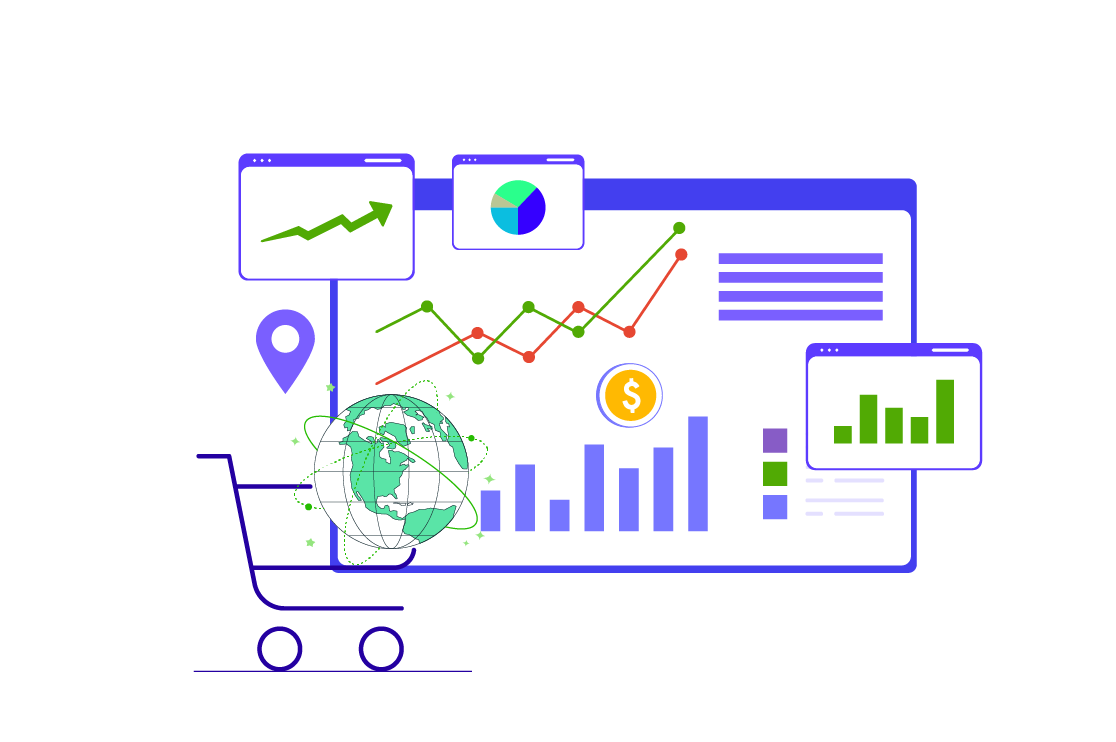
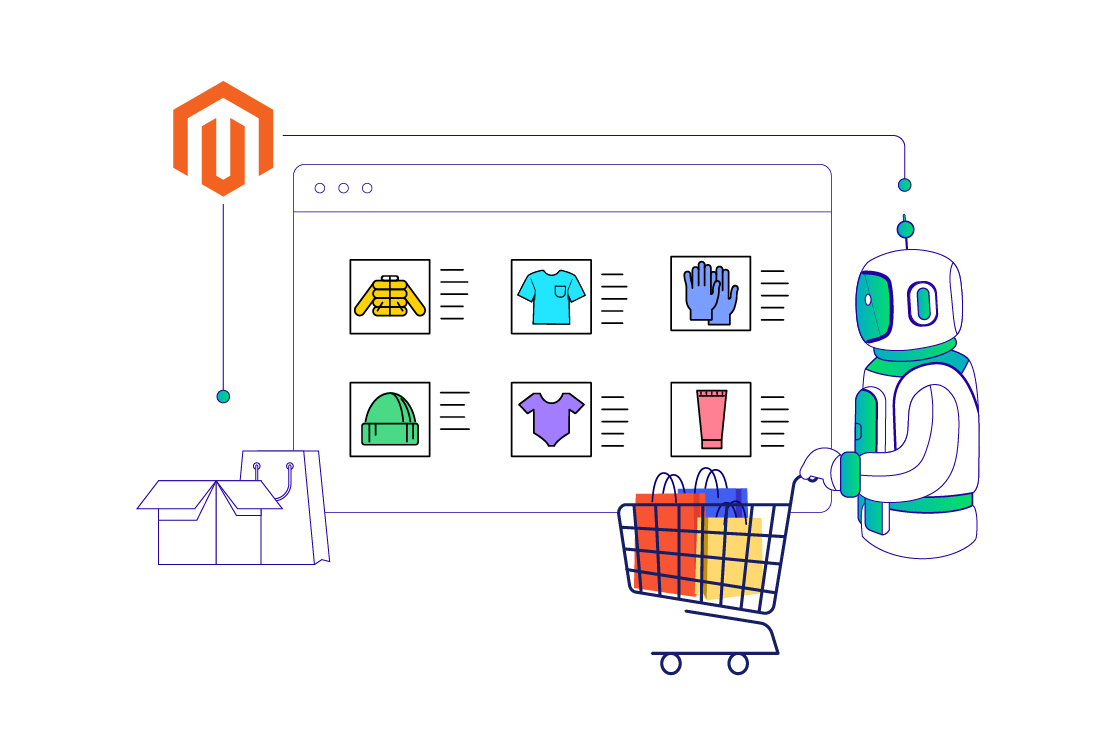 Magento AI Integration: Transform Your eCommerce Store Into an AI-Driven Revenue Engine
Magento AI Integration: Transform Your eCommerce Store Into an AI-Driven Revenue Engine  Sync Magento Store with Other B2C Ecommerce Platforms: A Guide to Multichannel Integration
Sync Magento Store with Other B2C Ecommerce Platforms: A Guide to Multichannel Integration 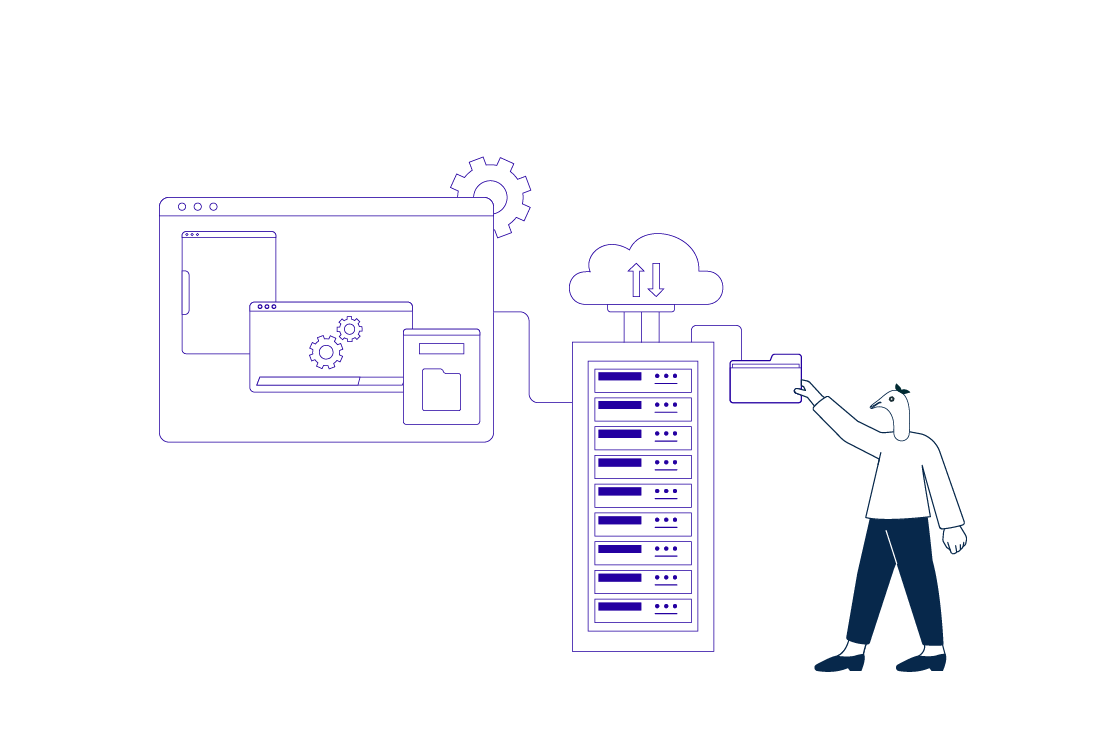 MACH Architecture for Unified Global Multi-Store Ecommerce: The Future of Headless Commerce
MACH Architecture for Unified Global Multi-Store Ecommerce: The Future of Headless Commerce 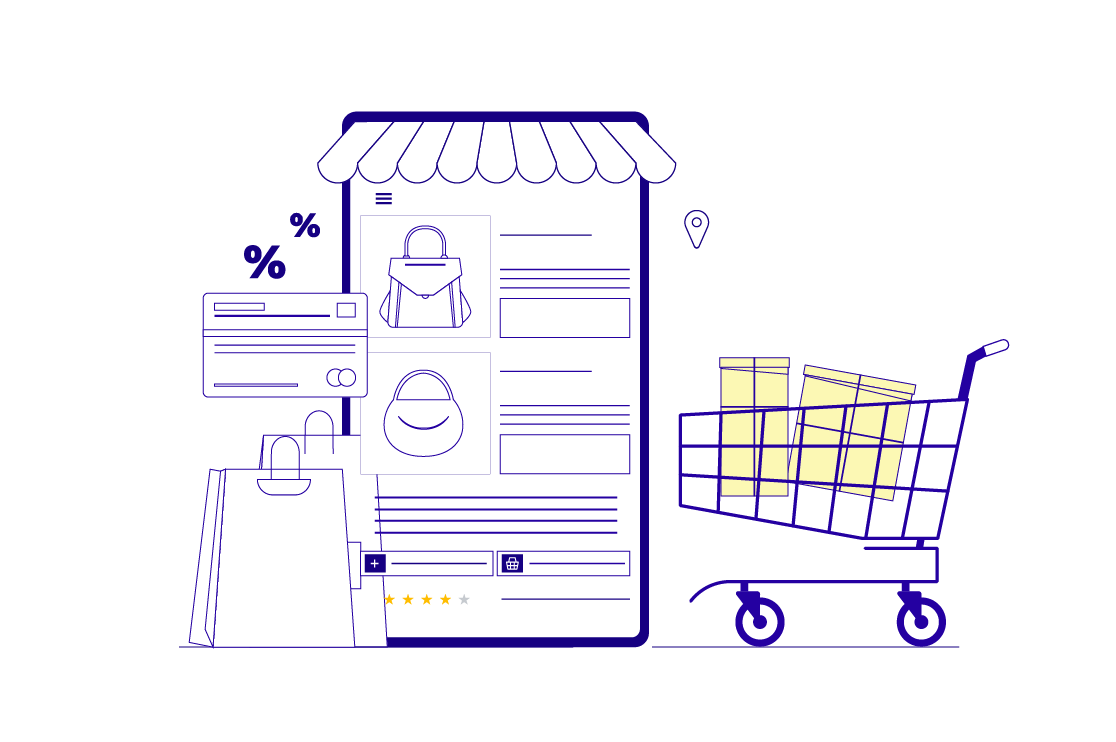 E-commerce Checkout Funnel: Why 60% of Your Customers Are Disappearing and What to Do About It
E-commerce Checkout Funnel: Why 60% of Your Customers Are Disappearing and What to Do About It 

